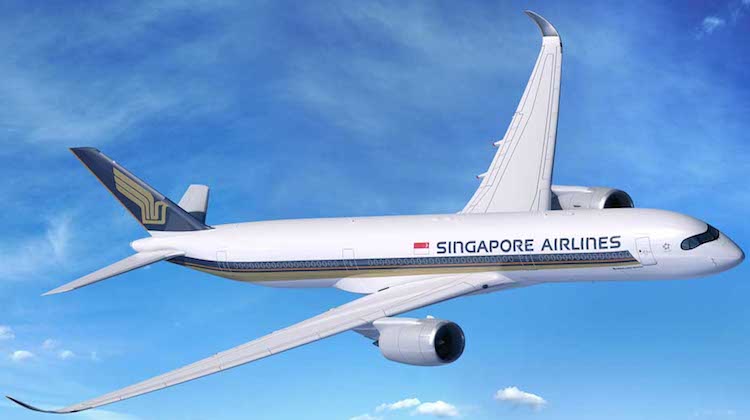
Qantas is calling on Airbus and Boeing to deliver an aircraft capable of operating nonstop from Australia’s east coast to London and New York within five years.
The airline has for some time harboured ambitions of nonstop flights from Sydney to the two cities sitting on the other side of the world that are among Australia’s most popular outbound destinations.
And it is now putting down a marker of 2022 to achieve to achieve the so-called “Holy Grail”.
Qantas says no aircraft currently in service has the range to fly these direct routes with passengers and luggage at full capacity, while the two most likely candidates currently in development – Boeing’s 777-8X and the Airbus A350-900ULR – “can get close”, it says.
“Qantas has issued a challenge to both Airbus and Boeing to extend the range of new aircraft under development and make these non-stop flights possible by 2022,” Qantas said in a statement on Friday.
In still air Sydney-London Heathrow is 9,188nm, while Sydney-New York JFK is 8,646nm. Currently, the world’s longest route by distance is Qatar Airways’ Doha-Auckland service at 7,848nm.
The Boeing website lists the 777-8X as having a range of 8,700nm and a passenger capacity of 350-375 passengers. The aircraft is expected to enter service in the early 2020s.
Meanwhile, the A350-900ULR is understood to have a maximum range of 9,700nm, sufficient to operate west-bound Sydney-London flights against prevailing headwinds.
Airbus has not published specific technical data on the A350-900ULR. However, a Reuters report in April said aviation experts believed the aircraft would be capable of carrying about 250 passengers on a Sydney-London service.
Singapore Airlines (SIA), which is the launch customer for the A350-900ULR, plans to use the aircraft to operate nonstop from Singapore to Los Angeles and New York. It is reported SIA plans to configure the aircraft with about 170 seats.

The Star Alliance member and Virgin Australia alliance partner expects to receive its first A350-900ULR in the middle to later part of 2018.
It was understood Qantas was seeking an aircraft capable of carrying 300 passengers in both directions on both the New York and London routes.
The 777-8X or A350-900ULR would sit alongside the Airbus A380 and Boeing 787-9 in Qantas’s long-haul fleet – with Airbus A330s used internationally mainly on medium-haul services to Asia – as the evergreen 747-400/400ERs are withdrawn.
“It’s expected all of Qantas’s 747s will be retired by the early 2020s, roughly in-line with the potential arrival of a new ultra-long range aircraft,” Qantas said.
“Hopefully we can fly direct from Sydney to London,” Qantas chief executive Alan Joyce said recently.
“We do believe aircraft technology is going to be our friend into the future,” Joyce told reporters at the International Air Transport Association (IATA) annual general meeting in Cancun, Mexico in early June.
“We’ve been waiting 97 years to be able to fly direct from Sydney and Melbourne. These are the aircraft that Qantas has always wanted.”
The extent of the challenge is perhaps best illustrated by Qantas’s Sydney-Dallas/Fort Worth Airbus A380 service, currently the fourth longest route in the world at 7,545nm.
Qantas international chief executive Gareth Evans confirmed in June payload restrictions mean there are occasions, albeit rare, where up to 100 seats were blocked off on the westbound leg. (Flights from the US to Australia can face stiff headwinds that lengthen journey time and therefore require more fuel.)
The oneworld alliance member, which is starting nonstop flights between Perth and London Heathrow (7,829nm) from March 2017 with Boeing 787-9s, says a nonstop Sydney-London Heathrow offering would cut four hours off the total travel time from the current one-stop routing.
Those headed to New York would save three hours off their travel time.
The time saved would come from from not having to transit, as well as not having the aircraft slow down prior to landing and the taxiing while on the ground.
Qantas said it was conducting wind route analysis as part of a feasibility assessment of the proposed routes.
“This involves processing up to 10 years’ worth of real-world weather patterns to run different flightpath scenarios to form a statistical picture of fuel burn (and therefore aircraft range) on the key routes,” Qantas said.
“This analysis is helping to provide savings in time and fuel burn.”
Meanwhile, it has established a partnership with the University of Sydney’s Charles Perkins Centre to learn more about the impact of long-haul travel on the passenger experience and better understand how elements such as movement, light, temperature, food and drink affect people before, during and after their flight.
(An in-depth feature of the Boeing 777X was in the July edition of Australian Aviation.)
Current longest nonstop passenger flights by distance (nautical miles)
1. Delhi-San Francisco (8,285nm*) operated by Air India with Boeing 777-200LR (*Pacific Ocean routing eastwards from Delhi only)
2. Doha-Auckland (7,848nm) – operated by Qatar Airways with Boeing 777-200LR.
3. Dubai-Auckland (7,668nm) – operated by Emirates with Airbus A380
4. Sydney-Dallas/Fort Worth (7,454nm) – operated by Qantas with Airbus A380
5. San Francisco-Singapore (7,339nm) – operated by United with Boeing 787-9 and Singapore Airlines with Airbus A350-900
6. Atlanta-Johannesburg (7,333nm) – operated by Delta with Boeing 777-200LR
7. Abu Dhabi-Los Angeles (7,291nm) – operated by Etihad with Boeing 777-200LR
8. Dubai-Los Angeles (7,246nm) – operated by Emirates with Airbus A380
9. Jeddah-Los Angeles (7,240nm) – operated by Saudia with Boeing 777-300ER
Planned future routes
1. Singapore-New York (Newark*) (8,285nm)– to be operated by Singapore Airlines with Airbus A350-900ULR. From 2018. (*Airport choice not confirmed)
2. Perth-London Heathrow (7,829nm) – to be operated by Qantas with Boeing 787-9. From March 24 2018
3. Singapore-Los Angeles (7,621nm) – to be operated by Singapore Airlines with Airbus A350-900ULR. From 2018
Speculated routes
1. Sydney-London (LHR) (9,188nm) – Qantas
2. Sydney-New York (JFK) (8,646nm) – Qantas
3. Sydney-Chicago (ORD) (8,022nm) – Qantas
4. Melbourne-Dallas/Fort Worth (7,814nm) – Qantas
5. Doha-Santiago (7,791nm) – Qatar Airways










